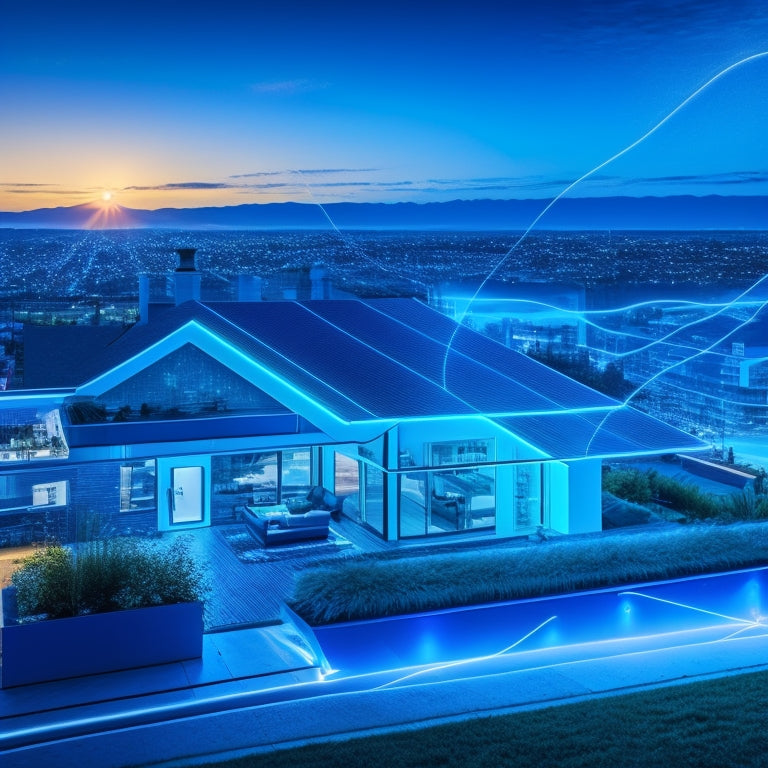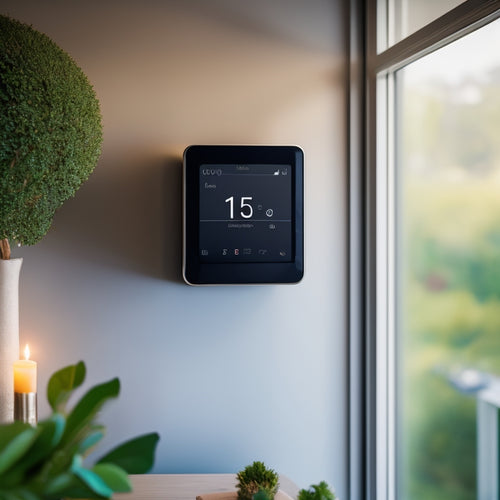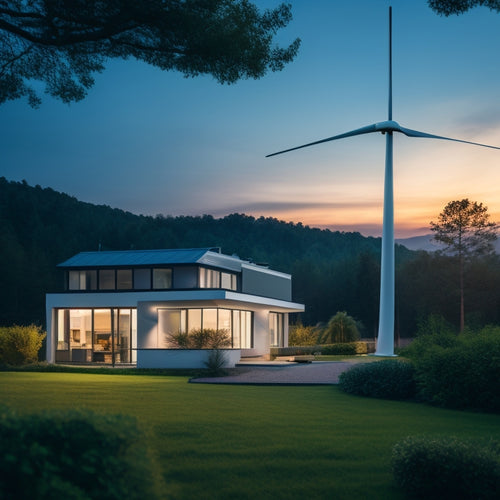
What AI Predicts Your Home's Energy Consumption?
Share
Your home's energy consumption is predicted by artificial intelligence (AI) powered by machine learning algorithms that analyze your daily energy usage patterns, appliance-specific energy consumption, and weather data to provide accurate forecasts and personalized recommendations for optimizing your energy efficiency. These algorithms, such as neural networks, identify patterns and correlations in your energy data, allowing for the development of models that can make accurate predictions. By integrating weather data and real-time energy usage monitoring, AI can provide a thorough understanding of your home's energy consumption, helping you uncover opportunities for energy expense savings and reductions in your carbon footprint, and there's more to investigate regarding how AI can tailor its observations to your specific needs.
Key Takeaways
- AI-powered machine learning algorithms analyze energy data to predict consumption patterns and optimize energy distribution.
- Neural networks identify correlations between energy usage and factors like weather, time of day, and appliance usage.
- Predictive models are trained on robust algorithms, including data normalization, feature selection, and hyperparameter tuning, to ensure accuracy.
- Advanced predictive modeling adapts to changes in occupancy patterns, identifying daily routines to optimize energy consumption based on presence.
- Real-time energy monitoring and feedback enable users to make informed decisions and prevent waste, leveraging IoT integration and granular data collection.
Machine Learning in Energy Forecasting
As energy consumption forecasting continues to play an essential role in optimizing energy distribution and reducing waste, machine learning has emerged as a key enabler in this domain.
You're now able to utilize machine learning algorithms to improve the accuracy of your energy consumption predictions. By applying feature selection techniques, you can identify the most relevant factors influencing energy consumption, such as weather patterns, time of day, and appliance usage.
This is particularly important when considering the integration of renewable energy sources into the grid, as it allows for more efficient planning and management of energy resources.
Moreover, understanding energy consumption patterns can help utilities and consumers optimize their energy mix and enhance sustainability efforts.
Regression analysis methods, like linear regression and decision trees, can then be used to model the relationships between these factors and energy consumption.
Neural Networks for Home Energy Prediction
You'll now investigate the neural networks that drive home energy prediction, which rely on thorough energy data analysis to identify patterns and correlations.
These patterns are then used to develop machine learning models that can learn from the data and make accurate predictions.
By integrating energy storage and management systems, like those used in roof-mounted energy solutions for box trucks and vans, homeowners can optimize their energy consumption and reduce their reliance on fossil fuels energy independence.
Energy Data Analysis
Within the domain of home energy prediction, analyzing energy data is an essential step in creating accurate forecasts. You need to understand your energy trends and consumption patterns to optimize your energy usage.
Furthermore, incorporating sustainable practices in energy management, such as route and schedule optimization, can greatly reduce fuel consumption and emissions. In addition, leveraging renewable energy sources, like solar power, can stabilize energy costs and reduce fossil fuel dependency.
- Cost analysis: Break down your energy expenses to identify opportunities for cost savings.
- Usage behavior: Analyze your energy usage patterns to identify inefficiencies and opportunities for improvement.
- Efficiency benchmarks: Compare your energy usage to industry benchmarks to identify areas for improvement.
Machine Learning Models
By analyzing your energy data, you've gained significant knowledge into your consumption patterns and identified areas for improvement.
Now, it's time to develop machine learning models that can accurately predict your home's energy consumption. Neural networks are a popular choice for this task, as they can learn complex patterns in energy usage data.
To build an effective model, you'll need to select the most relevant features from your dataset, such as weather data, time of day, and appliance usage. This process is called feature selection.
Additionally, integrating renewable energy solutions can further optimize energy usage and reduce carbon footprint. For instance, solar-powered charging systems can promote eco-friendly energy use.
Once you've trained your model, you'll need to evaluate its performance using metrics like mean absolute error or coefficient of determination.
Thorough model evaluation guarantees that your predictions are reliable and accurate, giving you the understanding you need to optimize your energy usage.
Predictive Algorithm Training
As the complexity of home energy consumption patterns grows, so does the need for strong predictive algorithms to accurately forecast energy demand. To attain this, you'll need to train your neural network using a sturdy predictive algorithm. This involves preparing your data through techniques like data normalization, which guarantees all features are on the same scale, and feature selection, which identifies the most relevant factors influencing energy consumption.
Moreover, incorporating knowledge from sustainable charging solutions, such as green energy infrastructure, can enhance the accuracy of energy demand forecasting. Additionally, understanding the role of renewable energy sources in reducing carbon footprint can also inform the development of predictive algorithms.
To develop an effective predictive algorithm, follow these essential steps:
- Data preprocessing: Clean and modify your data to make it suitable for training.
- Model selection: Choose the most suitable neural network design for your problem.
- Hyperparameter tuning: Optimize your model's parameters to achieve the best results.
Energy Consumption Pattern Analysis
You'll examine energy usage profiles, which provide a detailed breakdown of your home's energy consumption habits.
These profiles help identify daily consumption cycles, such as peak usage hours and energy-intensive appliances.
Energy Usage Profiles
Energy usage profiles, a key component of energy consumption pattern analysis, provide a detailed breakdown of a household's energy usage habits.
By analyzing your energy usage patterns, you can identify areas where you can make changes to reduce your energy consumption. This information is essential for understanding energy behavior trends and tackling consumption forecasting challenges.
Here are three key aspects of energy usage profiles:
-
Time-of-use analysis: This examines your energy consumption patterns at different times of the day, week, or month.
-
Appliance-specific energy usage: This breaks down energy consumption by individual appliances, such as refrigerators, air conditioners, and lighting.
-
Seasonal energy usage variations: This looks at how your energy usage changes throughout the year, considering factors like weather and daylight hours.
Daily Consumption Cycles
Your daily consumption cycle, an essential aspect of energy consumption pattern analysis, reveals the rhythmic patterns of your household's energy usage over a 24-hour period. This cycle is shaped by your lifestyle influences, occupancy patterns, and energy habits. By analyzing your daily usage, you can identify peak hours, consumption trends, and device impacts that drive your energy consumption.
| Time of Day | Energy Consumption Pattern |
|---|---|
| Morning (6am-10am) | High energy usage due to morning routines (cooking, showering, etc.) |
| Afternoon (12pm-4pm) | Moderate energy usage from household appliances and devices |
| Evening (6pm-10pm) | Peak energy usage from lighting, entertainment, and cooking |
Understanding your daily consumption cycle is essential for implementing efficiency practices and reducing your energy bills. AI-powered analysis can help you identify areas of improvement, considering seasonal variations and behavioral analysis.
Weather Data Integration Techniques
By incorporating weather data into AI-powered home energy consumption prediction models, researchers can considerably enhance their accuracy. You can tap into various data sources, such as national weather services or IoT devices, to collect weather data.
However, integrating this data into your model can be challenging due to its varying granularity and regional differences.
To overcome these integration challenges, consider the following techniques:
-
Data aggregation: Combine weather data from multiple sources to increase forecasting accuracy and reduce uncertainty.
-
Seasonal decomposition: Break down weather data into seasonal variations to capture historical trends and climate impact.
-
Spatial interpolation: Use spatial interpolation methods to fill in gaps in weather data and improve model validation.
Real-Time Energy Usage Monitoring
With weather data integration techniques in place, you can now focus on capturing the intricacies of home energy consumption patterns. Real-time energy usage monitoring is key to understanding your smart home's energy behavior. This is achieved through IoT integration, which enables the collection of granular data on your energy consumption.
| Feature | Description | Benefit |
|---|---|---|
| Energy Feedback | Receive instant updates on your energy usage | Stay informed and adjust habits |
| Consumption Alerts | Get notified when energy usage exceeds set thresholds | Avoid energy waste and high bills |
| Real-Time Analytics | View your energy consumption patterns in real-time | Identify areas for improvement and optimize energy use |
With real-time energy usage monitoring, you'll gain significant understanding into your user behavior and receive personalized recommendations to optimize your energy consumption. This will enable you to take control of your energy usage and make data-driven decisions to reduce your energy bills and carbon footprint.
Home Occupancy Scheduling Algorithms
Capturing home energy consumption patterns relies heavily on understanding occupancy schedules. As you aim for energy optimization in your smart home, occupancy prediction becomes vital. Your daily routines and user behavior markedly impact energy consumption.
To achieve scheduling flexibility, algorithms analyze occupancy patterns to identify opportunities for energy savings.
Here are three key aspects of home occupancy scheduling algorithms:
-
Algorithm accuracy: Advanced predictive modeling guarantees that the algorithm learns your occupancy patterns and adapts to changes in your schedule.
-
Occupancy pattern analysis: The algorithm identifies patterns in your daily routines, including when you're away or at home, to optimize energy consumption.
-
Smart home integration: The algorithm seamlessly integrates with your smart home devices to adjust energy usage in real-time, assuring maximum energy efficiency.
Appliance-Specific Energy Modeling
Modeling energy consumption at the appliance level is essential for optimizing energy efficiency in your smart home, as it enables the identification of energy-hungry devices and opportunities for reduction.
By analyzing appliance-specific energy usage, you can pinpoint areas for improvement and optimize your energy consumption. This involves appliance efficiency analysis, energy audits, and consumption benchmarking to determine which devices are using the most energy.
Usage forecasting and load profiling help you understand how your devices impact your overall energy consumption. Additionally, considering seasonal variations and user behavior helps refine your energy usage predictions.
Retrofit analysis can also identify opportunities to upgrade to more energy-efficient smart devices. With this level of granularity, you can make informed decisions to reduce your energy waste and optimize your home's energy consumption.
Data-Driven Energy Efficiency Optimization
You've identified the energy-hungry devices in your smart home and pinpointed areas for improvement.
Now, it's time to take action and optimize your energy consumption. Data-driven energy efficiency optimization is the next step. This involves using AI-driven understandings to adjust your energy usage patterns and reduce your carbon footprint.
To achieve this, focus on:
-
Renewable integration: Incorporate solar panels or wind turbines to generate clean energy and reduce reliance on non-renewable sources.
-
Efficient load management: Schedule energy-intensive tasks during off-peak hours or when renewable energy is available.
-
Smart automation: Use AI-powered automation to optimize energy usage, turning off devices when not in use or adjusting thermostat settings for maximum efficiency.
Frequently Asked Questions
Can AI Predict Energy Consumption for Older or Historic Homes?
You can adapt historic homes for energy efficiency by leveraging AI predictions, which consider unique design features and identify opportunities for upgrades, such as insulation, window replacements, and smart thermostats, to optimize energy consumption.
How Accurate Are AI Predictions for Homes With Unique Layouts?
As you maneuver through the labyrinth of your uniquely designed home, AI predictions may stumble upon hidden passages of inaccuracy, struggling to grasp the complexity of your layout's twists and turns, where unique features can skew results by up to 10%.
Do AI Energy Forecasts Account for Energy Usage of Outdoor Spaces?
You wonder if AI energy forecasts account for outdoor spaces; surprisingly, they often do, factoring in outdoor lighting and HVAC systems that extend into patios or decks, providing a more thorough energy usage snapshot.
Can AI Energy Predictions Be Used for Commercial Buildings Too?
You're illuminating a brighter path to commercial efficiency, and AI energy predictions can be your guiding light. By leveraging predictive maintenance, you can optimize energy usage in commercial buildings, unfastening significant cost savings and a more sustainable future.
Are Ai-Powered Energy Forecasts Compatible With All Smart Home Devices?
You're wondering if AI-powered energy forecasts can seamlessly integrate with all your smart home devices, enabling device integration and energy optimization. The answer is yes, most AI systems are designed to be compatible with popular devices, giving you freedom to monitor and control your energy usage.
Related Posts
-

Smart Energy: Greener Homes With Connected Power Devices
You can control and optimize your energy consumption with smart energy devices, reducing your carbon footprint by up ...
-

10 Grid-Tied Wind Power Systems for Modern Homes
You're looking for a grid-tied wind power system to utilize wind energy for your modern home. Here are ten options to...
-

10 Green Waste Solutions Every Homeowner Should Know
You can make a significant impact on the environment by implementing green waste solutions at home. Consider composti...


